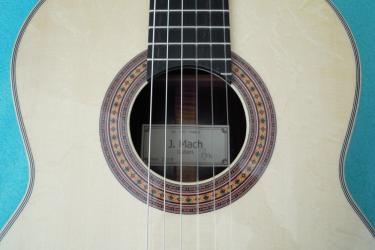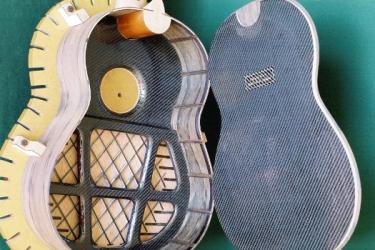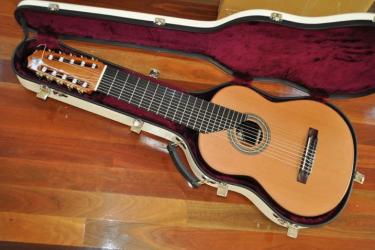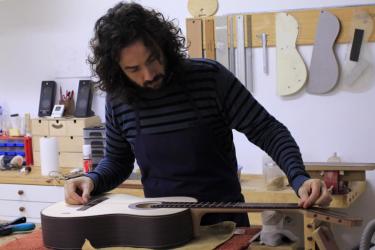Today's guest is Miles Henderson Smith from Falmouth, Cornwall, UK.
Q1. Could you please tell us a little about your luthiery and its history?
I made my fist guitar at the age of 19 in 1993 under the supervision of David Wooldridge, who was also my first guitar teacher.
I trained as a fine artist, completing a BA in fine art and later an MA in contemporary visual arts. Throughout my twenties and early thirties I worked as an artist and teacher. During this time I continued to play classical guitar.
In 2008 I was fortunate enough to be in a position to buy a new guitar; the kind of concert guitar I had always dreamed of owning. After much searching I chose a Kevin Aram. I went to visit Kevin and selected some beautiful wood and in doing so I fell in love once again with the tools, the smells and the possibility of guitar making. The idea was seeded that it may in fact be possible for me to make guitars professionally. As I waited for my guitar I obsessively researched guitar making and on returning to pick it up a year later I asked Kevin if he would be prepared to mentor me as a maker and to my delight he was. He has been extremely generous with the information and advice that he has given me and has been able to answer every question that I have put to him with great detail and knowledge. I have also been fortunate enough to have his guitar as a constant source of inspiration.
I set up my current workshop in Falmouth, Cornwall in 2009 and my instruments have steadily improved since then. By applying my skill and creativity as an artist and consistently focusing on a traditional design I think I have been able to produce some beautiful instruments.
Q2. Please describe your idea of a good sounding guitar, and what you do to achieve it?
My favourite guitars have a purity to the sound, when you play a note that's what you get uncluttered by too many over tones.
They also have an evenness across the range from the deepest to the highest note allowing the player to bring out certain voices in the music.
They have the possibility of providing a variety of colours from a full mellow tasto to a bright ponticello.
They have a good dynamic range, maintaining clarity between pianissimo and forte. I do not aim to make super loud or powerful guitars as some makers today do. The guitar is relatively quiet compared with other concert instruments and I see this as part of the guitars intimate charm. However I believe that a good guitar has the ability to project sound in a focussed way, so even when played quietly it is audible across a small hall.
The sound envelope of a note played on the guitar is what gives the guitar its unique character from the initial attack to its gradual dying away. The timbre produced by the classical guitar varies significantly between instruments and makers. Beyond the obvious indications of volume and pitch the use of language to describe the specific qualities of sound is problematic. I aim for a full rounded sound with velvety basses and smooth crystal trebles. My instruments have been described as having a "true" sound.
How to achieve all of these attributes in a single instrument is the million dollar question and what drives me to keep making another instrument. I believe that it is a balancing act. The soundboard, it's thickness, bracing and flexibility is known to be the single most important part of the guitar in producing sound and I take particularly meticulous care in thicknessing and constructing this part. I tend towards a light construction as advocated by Torres. However every part of the instrument contributes toward its overall resonance and care is taken over every detail. I tend to stick to a traditional design that is known to work well, any variations I make between instruments are highly considered and minimal.
The quality of materials used is extremely important and I source the best that I can.
As a maker I believe that craftsmanship is the single most important factor in giving each instrument its own unique aesthetic character not only visually but ultimately in the sound it produces. The fact that each instrument is individually handcrafted over a period of weeks means that something of the makers intent is imparted in it. I find it fascinating that whatever changes I make the resulting instrument is always recognisable as my own.
There are very few things in the world today that are made with the care and attention to detail with which a fine handcrafted guitar is made. My instruments are made to last and become more beautiful with age as opposed to the latest electrical gadget that becomes obsolete within a year or two.
Q3. Please tell us about your idea of improving playability, and what you do to achieve it?
The first thing that many players look for in a guitar is that it has a good action. Often players want it as low as possible. The neck geometry that I use leaves the saddle quite high at the bridge. This gives the string a higher break angle imparting more of the strings vibrational energy to the soundboard. It also means that the action can be lowered if desired. Something that fewer players think about when choosing a guitar is the efficiently with which the energy from the string is amplified through the soundboard. An instrument that makes a sound with little effort will be much easier play. I aim to achieve this in a number of ways but mainly by making the sound board as light and springy as possible.
Q4. Please tell us your opinion about the traditional finishing method (French polish) and new methods (lacquer, catalysed finishing, etc).
I tend to use a hand rubbed oil finish on my guitars. I am struck by the beauty, both visually and in the sound that an oil finish produces. I personally associate this finish with best of English guitar making, not that it is used exclusively by English luthiers but it is used by some with very fine effect. The oil is exceptionally thin and flexible allowing the wood to vibrate freely. It is also not prone to the crazing that French polish can develop over time. I can't stand the thick nitro spray finish used on many factory built guitars. These thicker finishes help to cover up any imperfections in the build under a uniformly homogeneous glossy gloop. The oil however is unforgiving accentuating every minute detail and exposing the craftsmanship that has gone into the build.
Q5. Please tell us your opinion regarding shorter-scale guitars such as 640, 628 and 615mm in terms of playability, design, sound quality and volume. Is there an increasing need to cater to smaller-handed or female players?
I tend to go with the standard scale length of 650 but with the body shape or plantilla that I use a scale length between 640 or 660 can be used without adversely affecting the sound. I know players with smaller hands who are perfectly happy playing a 650 scale length and others who prefer 640. The width of the fretboard at the nut and at the 12th fret can also be altered slightly to suit different sized hands.
Q6. Do you have a preference for any particular string type or tension when you design/make your guitars?
I use d'Addario normal tension strings. I use these as they are consistently good and I know what to expect. There are so many variables when making a guitar so it is important to keep the strings as a fixed. Personally I think that the medium tension strings work well as they allow the soundboard to vibrate freely, higher tension strings can stifle the sound.
Having said this the preference in strings is ultimately the players choice.
Q7. How does the increasing rarity of some woods, rosewood for example, impact on your methods, and the quality of the end product?
The soundboards of my guitars are alpine spruce from forests that have been well managed and supplied the musical instrument trade for centuries. For the back and sides I usually use East Indian rosewood of the highest quality this continues to be readily available for guitar making. There are many alternative species of exotic hardwoods available that are known to have good perhaps even superior resonant qualities and make beautiful instruments such as various other species of rosewood, ziricote, cocobolo, black wood etc. However these woods are often rare and can be significantly more expensive. There are also more sustainable and locally sourced materials available such as cherry, yew, sycamore or London plane, while these woods have performed favourably in blind testings they still tend to be unpopular amongst most classical players. If a customer has a preference for a particular combination of woods I am happy to oblige.













